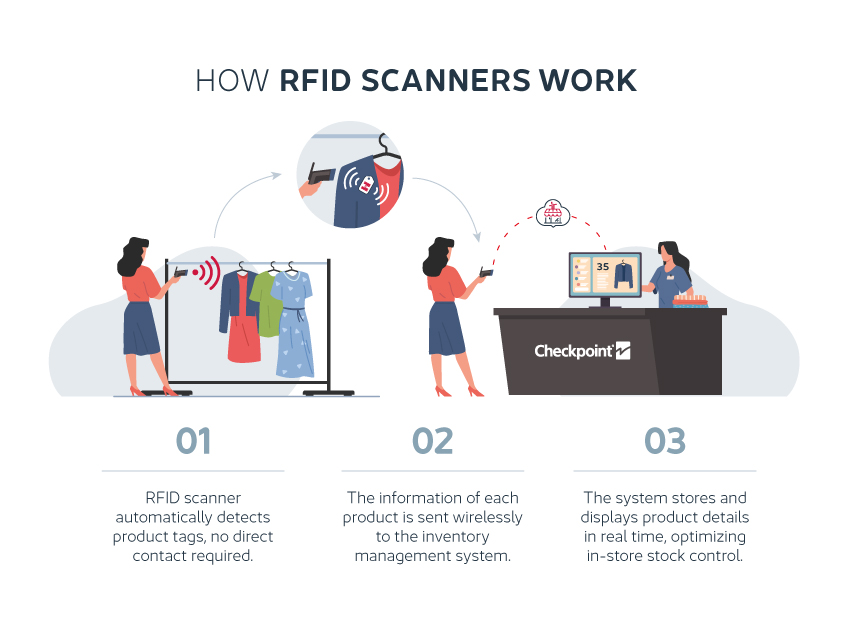In a world where businesses are always looking for smarter ways to work, RFID scanners are becoming a game-changer. These devices are more than just tech gadgets—they're reshaping how companies keep track of inventory, manage assets, and even enhance customer experiences. Whether it’s a retailer ensuring shelves are stocked, a logistics company tracking shipments, or a warehouse streamlining its supply chain, RFID scanners are helping to make operations smoother and more efficient.
This article examines how RFID scanners are used today, their benefits, practical applications, and more information about RFID readers.
What is an RFID Scanner and How Does it Work?
It is a sophisticated device that uses radio waves to wirelessly identify and track objects. The technology behind it is simple yet powerful, comprising three main components: the RFID reader, the tag, and the antenna.
- RFID Reader: This device emits radio signals to detect RFID tags. It can take various forms, from handheld devices to fixed units installed in strategic locations within a facility. The reader generates an electromagnetic field that activates an RFID tag, sending back the stored information.
- Antenna: This communication between the reader and the tag is important. It transmits the reader's signal to the tag and then back to the reader.
- RFID Tag: These tags are attached to objects that need to be identified or tracked. They contain a microchip that stores data about the object, such as its ID, location, or other relevant details.

Advantages of RFID Scanners in Various Industries
RFID scanners have become essential tools across different sectors due to their numerous advantages over traditional tracking and inventory management methods. Here are some of the key benefits that make RFID scanners a popular choice:
- Speed and Efficiency: Unlike barcode systems, which require a line-of-sight scan for each item, RFID scanners can read multiple tags at once, even from a distance. This capability significantly speeds up processes like inventory counts, shipping, and receiving, allowing businesses to save time and reduce labor costs.
- Accuracy: RFID scanners significantly reduce the likelihood of human error. Manual data entry and barcode scanning are prone to mistakes, but RFID automates the process, ensuring that data is captured accurately and consistently. This level of precision is crucial in industries where accurate data is essential, such as healthcare or airports.
- Security: RFID scanners can enhance security by controlling access to restricted areas and tracking the movement of high-value assets. For example, RFID tags can trigger alarms if tagged items are moved out of designated areas without authorisation. This helps businesses keep better control over their assets and reduces losses.
Real-World Applications of RFID Scanners
The flexibility of RFID technology allows it to adapt to various environments and needs. Here are some of the most impactful real-world applications of RFID scanners:
- Logistics and Supply Chain Management: RFID scanners are essential for managing the flow of goods through the supply chain. They are used to track inventory, monitor the condition of products in transit (such as in cold chain logistics), and control access to warehouses and storage facilities.
- Retail: In retail, RFID is transforming inventory management by providing real-time data on stock levels, reducing out-of-stock situations, and enabling more accurate demand forecasting. RFID is also used for loss prevention and to enhance the customer experience through contactless payments and automated checkout.
- Libraries and bookstores: RFID tags have transformed library management and the publishing industry by providing an efficient and accurate method for tracking books. These store key information such as title, author, and ISBN, and use wireless communication to transmit data when near a reader. It allows for both reading and updating information, making inventory management faster and reducing errors. RFID also enhances the user experience by enabling precise tracking of book locations, improving accessibility, and streamlining operations for libraries, bookstores, and publishers.
Key Features of RFID Scanners
Checkpoint's RFID readers offer unprecedented precision by providing a three-dimensional map showing the location and movement direction of tagged merchandise. This versatile technology comes in three formats: ceiling-mounted, underfloor, and antenna-based, allowing stores to configure the scanners according to their specific needs. The combination of hardware and software ensures data integrity, providing stores with detailed insights into item movement while reducing false alarms through intelligent detection. This feature allows more merchandise to be displayed near the entrance without triggering unnecessary alarms.
RFID readers can detect if an item is near the door, moving in the vicinity of the exit, or heading outside, only triggering the alarm in the case of a potential theft. With a reading range of more than 6 meters, this technology not only improves accuracy in item tracking but is also ideal for use in Electronic Article Surveillance (EAS) tasks, offering a flexible solution that can include visible deterrents if needed.
In addition, RFID technology is transforming the point-of-sale (POS) by providing a faster and smoother checkout experience. By integrating it into payment systems, retailers can automate processes, streamline transactions, and reduce queues, significantly improving the customer experience. This technology can leverage existing RFID programs, optimising inventory accuracy and facilitating detailed analysis of purchases and returns. In addition, by implementing RFID as a loss prevention and protection system, stores not only speed up the checkout process but also improve security.
Thanks to Checkpoint technology, the door is opened to a frictionless checkout experience, increasing efficiency for both employees and customers, and offering new omnichannel possibilities in retail.
